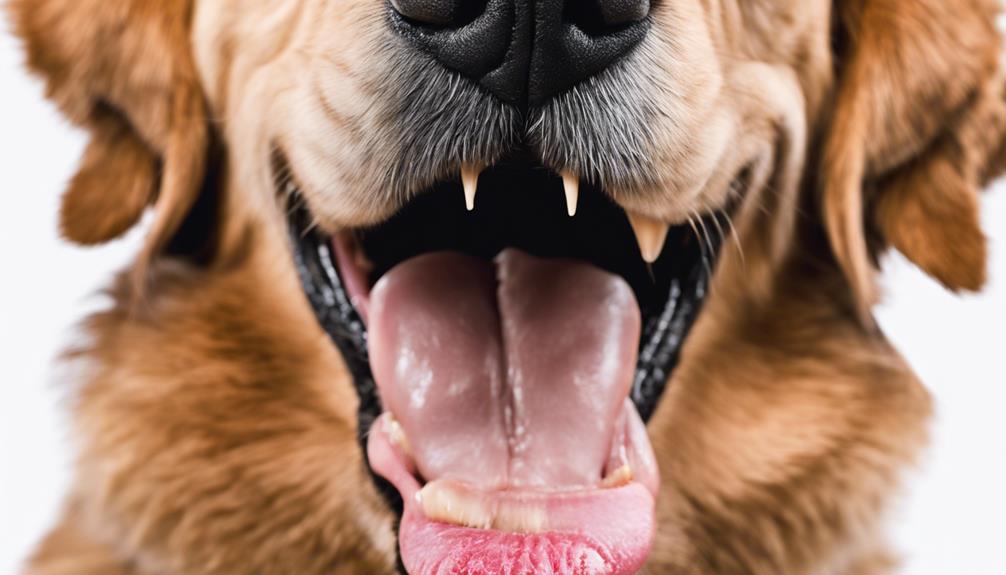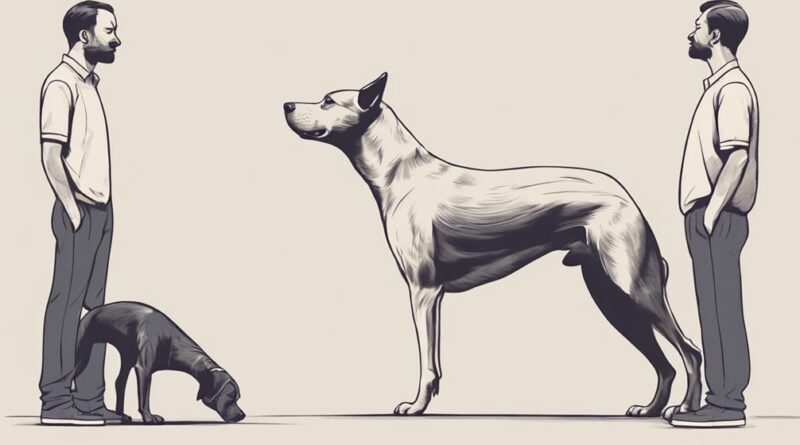How-to Guide: Interpreting Canine Body Language
When your dog lowers its head and puts its ears back, it might not necessarily mean submission. Canine body language can often be misinterpreted, leading to misunderstandings between humans and their furry companions.
By learning to decipher the subtle cues your dog is giving you, you can strengthen your bond and ensure better communication. Understanding these signals will help you respond appropriately to your dog's needs and emotions.
Understanding Canine Facial Expressions
To grasp the meaning behind a dog's facial expressions, observe their eyes, ears, and mouth for valuable cues. When a dog sniffs intently, it's not just about exploring scents; this behavior can also be a communication cue. Dogs use sniffing to gather information about their environment and other animals.
If a dog yawns, it mightn't simply mean they're tired. Yawning can actually be one of the stress indicators in dogs. It's a way for them to release tension or to communicate that they're feeling uncomfortable in a situation. Pay attention to the frequency of yawning, as excessive yawning could indicate persistent stress or anxiety.
Understanding these subtle facial cues can help you better comprehend your furry friend's feelings and needs. By being attentive to their expressions, you can strengthen your bond and ensure a harmonious relationship with your canine companion.
Decoding Tail Wagging
When observing a dog's body language, pay close attention to the nuances of their tail wagging as it can reveal valuable insights into their emotions and intentions. The way a dog wags its tail can communicate a lot more than just happiness. Understanding tail language is crucial in deciphering your furry friend's emotional cues. Here's what to look for:
- Tail Language: A relaxed and natural tail wag usually indicates a friendly and approachable demeanor. A tail held high with small, quick wags can signal excitement, while a low tail with slow wags might suggest uncertainty or submissiveness.
- Wagging Intensity: The intensity of the wag can also provide clues about their communication levels. A broad, vigorous wag often signifies a strong positive emotion, whereas a slow, gentle wag may indicate wariness or caution.
- Emotional Cues: Keep an eye on the position and movement of the tail in conjunction with other body language signals to get a more comprehensive understanding of your dog's emotional state.
Interpreting Ear Positions
Pay attention to your dog's ear positions as they serve as another key indicator of their current emotional state and can complement the messages conveyed through their tail wagging.
When you notice your dog's ears twitching or tilting their head to the side, it may indicate that they're curious or trying to focus on a particular sound or object. On the other hand, if their ears are drooping, it could suggest that they're feeling sad, anxious, or unwell.
Conversely, when your dog's ears perk up, it often signifies alertness, excitement, or interest in something happening around them. Understanding these different ear positions will help you better interpret your dog's feelings and respond appropriately to their needs.
Reading Canine Eye Contact
Interpreting your dog's eye contact is crucial for understanding their emotional state and communication cues. When it comes to reading canine eye contact, here are some key points to keep in mind:
- Eye contact signals:
- Direct eye contact: A confident or assertive posture.
- Averted gaze: Often a sign of submission or discomfort.
- Staring with a relaxed face: Could indicate curiosity or playfulness.
- Interpretation tips:
- Pay attention to the context: Consider the situation your dog is in.
- Know your dog's baseline: Understand what's normal behavior for your dog.
- Consider other body language cues: Eye contact should be interpreted alongside other signals like ear positions and body posture.
Analyzing Body Posture
Understanding your dog's body posture is essential for gaining insights into their emotions and intentions. By analyzing gait patterns, you can learn a lot about how your dog is feeling. A confident dog will walk with a relaxed and smooth gait, while a fearful or anxious dog may exhibit stiff movements or even try to make themselves appear smaller by crouching or lowering their body. Paying attention to these subtle cues can help you better understand your furry friend.
In addition to gait patterns, it's crucial to be able to identify stress signals in your dog's body posture. Common stress signals include lip licking, yawning, panting when not hot or thirsty, and avoiding eye contact. If you notice these signs, it's important to assess the situation and try to alleviate any stressors your dog may be experiencing.
Recognizing Vocalizations
By listening attentively to your dog's vocalizations, you can gain valuable insights into their current state of mind and emotions. Dogs use different vocal cues to communicate various feelings, and understanding these sounds can help you better respond to your furry friend.
Here's a breakdown to help you interpret your dog's vocalizations:
- Bark Communication: Dogs bark for various reasons, such as to alert you of something, express excitement, or even show anxiety. The tone, frequency, and intensity of the bark can provide clues about what your dog is trying to convey.
- Growl Meaning: Growling is often misunderstood as a sign of aggression, but it can also indicate fear, discomfort, or a desire to play. Pay attention to the context in which your dog growls to better understand their emotions.
- Whimper Interpretation and Howl Significance: Whimpering can signal pain, anxiety, or a need for attention. Howling, on the other hand, is a form of communication that can express loneliness, excitement, or even a response to certain sounds. Understanding the reasons behind these vocalizations can strengthen your bond with your canine companion.
Assessing Mouth and Lip Movements

When observing your dog's body language, pay close attention to their mouth and lip movements as they can provide important clues about their feelings and intentions. Lip licking is a common behavior that can indicate stress or anxiety in dogs. If you notice your dog excessively licking their lips in a situation, it may be a sign that they're feeling uncomfortable or nervous.
Additionally, snarling, where a dog curls its lips to show teeth, is a clear indicator of aggressive behavior. This gesture is often accompanied by growling and can signal that your dog is feeling threatened or is ready to defend themselves. Understanding these mouth and lip movements can help you interpret your dog's emotions accurately and respond accordingly to ensure their well-being.
Observing Overall Body Language
To gain a comprehensive understanding of your dog's emotional state, carefully observe their overall body language. This includes analyzing movement patterns and assessing energy levels. Here's how you can interpret your dog's overall body language:
- Posture: Pay attention to how your dog is standing or sitting. A relaxed and neutral posture indicates a calm state, while a tense body with raised hackles may suggest aggression or fear.
- Tail Wagging: Contrary to popular belief, a wagging tail doesn't always mean a happy dog. The speed and height of the wag, along with the position of the tail, can provide insights into your dog's mood.
- Eyes and Ears: The eyes and ears are windows to your dog's soul. Wide eyes and perked-up ears can signal alertness or excitement, while squinting eyes and flattened ears may indicate discomfort or anxiety.
Frequently Asked Questions
How Can I Tell if My Dog Is Feeling Anxious or Stressed Based on Their Body Language?
You can tell if your dog is feeling anxious or stressed by observing their body language. Signs of anxiety or stress in dogs include panting, pacing, trembling, licking lips, yawning excessively, and avoiding eye contact.
Understanding canine emotions is crucial for recognizing these signals. By paying attention to your dog's behavior and body movements, you can better assess their emotional state and provide appropriate support and comfort when needed.
What Should I Do if My Dog's Body Language Indicates Aggression Towards Another Dog or Person?
If your dog shows signs of aggression towards another dog or person, it's crucial to stay calm and avoid escalating the situation. Use de-escalation techniques like creating distance or redirecting their attention.
Training methods can help modify their behavior over time. Consider seeking professional intervention for more severe cases and implementing behavioral modification strategies to address the root cause of the aggression.
Are There Specific Body Language Cues That Indicate a Dog Is in Pain or Discomfort?
If your dog is in pain or discomfort, there are specific body language cues to watch out for. Signs like:
- whining
- panting excessively
- licking a specific area
- being more withdrawn than usual
Can indicate something's wrong. Pay attention to changes in their posture, reduced appetite, or reluctance to move. Keep an eye out for these signs to identify when your furry friend might be feeling unwell and seek veterinary care promptly.
How Can I Differentiate Between Playful Body Language and Aggressive Body Language in My Dog?
To differentiate between playful and aggressive body language in your dog, observe their cues closely. Playful signs include:
- Wagging tail
- Relaxed body
- Inviting play posture
Aggressive signals may involve:
- Stiff body
- Raised fur
- Growling
- Direct eye contact
Pay attention to the overall context and your dog's behavior patterns to accurately interpret their intentions.
Understanding these body language cues will help you respond appropriately to your furry friend's needs.
Can a Dog's Body Language Vary Depending on Their Breed or Individual Personality?
Yes, a dog's body language can vary based on their breed and individual personality. Different breeds may exhibit specific behavioral cues or communication signals unique to their breed characteristics.
Additionally, a dog's personality traits can also influence how they express themselves through body language. It's essential to consider both breed differences and individual personality when interpreting a dog's body language to better understand their emotions and intentions.
Conclusion
So next time you're interacting with a dog, remember to pay attention to their:
- Facial expressions
- Tail wagging
- Ear positions
- Eye contact
- Body posture
- Vocalizations
- Mouth and lip movements
- Overall body language
By understanding and interpreting these cues, you'll be better equipped to communicate with and understand your furry friend. Keep practicing and observing their behavior to strengthen your bond and improve your relationship with your canine companion.
